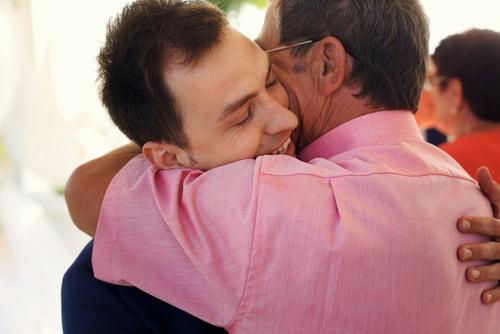Over the centuries, various forms of interpersonal touch have become less common, influenced by changes in cultural values and new technology. Nowadays, with twenty-four-hour access to mobiles, texting, and email, many people spend more time interacting with their technology than they do with each other. This lack of touch has many effects on different aspects of our lives and can lead to feelings of loneliness, isolation, and insecurity.

So why is touch so important to us? We typically think of touch as a pleasant, but not very important part of life. But touch plays an integral role in our daily experiences. It influences what we buy, what we eat, who we love, and even how we heal. We use our sense of touch to gather information about our environment and to establish social bonds with each other.
Multiple studies have concluded that touch, especially hugging, provides numerous health benefits. If you’re looking for a great way to boost your immune system, reduce your stress, improve your sleep and even help cure depression, you need to consider hugging. Hugs have no side effects and require no prescription. Even better, they’re free and can be given and received anywhere, at any time.
Here are 20 great reasons why you should hug and allow yourself to be hugged every single day:
1. Hugging Helps to Fight Stress Induced Illness
It’s a well-known fact that stress can weaken the immune system, leading to colds and other illnesses. As the body tries to cope with stressful situations, it responds by becoming physically sick.
Scientists have been investigating the link between physical touch and a healthy immune system. In a 2015 study involving 404 healthy adults, researchers from Carnegie Mellon University examined the effects of receiving hugs on the immune system. Participants were tested for their susceptibility to the common cold, after being exposed to the virus.
It turns out that the people who received more hugs, and greater social support, were less likely to get sick. In fact, researchers calculated that the stress-buffering effects of hugging explained thirty-two percent of that beneficial effect. And amongst those participants that did get a cold, those that received hugs reported fewer symptoms.[1]
The researchers concluded that hugs are a way of providing support, and being hugged more frequently could be an effective means of reducing stress and stress-related illness.[2]
Bottom line: Hugs help us fight stress and keep us healthier.
2. Hugging Boosts Our Immune System
Hugs strengthen the immune system. When you hug someone you are placing some gentle pressure on their sternum. This activates the Solar Plexus Chakra and stimulates the thymus gland. The thymus gland regulates and balances the body’s supply of white blood cells, keeping you healthy. [3]
The link between touch and a healthy immune system is also documented in a 2010 study published in the journal Developmental Review. The study examined the effects of massage therapy and concluded that participants showed a noticeable drop in heart rate and blood pressure. They also exhibited a boost in their immune systems, increasing their white blood cell count and decreasing their levels of cortisol.[4]
Bottom line: Hugs boost the body’s immune system and keep us healthy.
3. Hugging Reduces Stress
When we are stressed, our nerve endings send information to the body to release the hormone cortisol. This hormone slows down the body’s healing process. Cortisol stimulates the body’s ‘fight or flight’ response, which, if not controlled, creates a number of health problems.
Studies have shown that hugging can affect cortisol levels in the body by causing the release of a hormone, oxytocin, known as the ‘love hormone’. Oxytocin is also referred to as the hug hormone, cuddle chemical, moral molecule, and the bliss hormone due to its effects on behavior, including its role in love and in female reproduction.[5]
When we receive a hug, the body releases oxytocin, making us feel calmer and more relaxed, and stress levels are reduced. The oxytocin acts on the limbic system, the brain’s emotional centre, promoting feelings of contentment, reducing anxiety and helping women endure the pain of childbirth. Matt Hertenstein, a psychologist at DePauw University describes oxytocin as promoting feelings of devotion, trust and bonding, and says it lays the biological foundation and structure for connecting to other people.[6]
Bottom line: Hugs reduce stress by releasing oxytocin which relieves anxiety and helps us to bond.
4. Hugging Satisfies Our ‘Skin Hunger’
Skin is the body’s largest organ. It acts as a defense against the outside world, regenerating at an incredible rate Skin is also our brain’s data collector. The soles of our feet, the tips of our fingers, and our lips are all specially designed to collect the smallest details of sensory data and transmit them to the brain via nerve endings.[7]
Touch is the very first sense that we acquire, so it makes sense that touch and physical contact is necessary for our well being.
Sadly, many people are touch-deprived. One study found that one-third of people receive no hugs on a daily basis while 75 percent said they wanted more hugs.[8]
Humans become nearly unrecognizable in the absence of touch. Two hundred years ago, French scientists spotted a creature resembling a human running through the forests. Eventually, the creature was caught, and it turned out to be an 11-year-old boy. They named the child Victor and determined that he had been living wild in the forest for most of his life. Initially doctors thought that Victor was mentally retarded, but eventually, the physicians and psychiatrists concluded that he had been deprived of human physical touch, which had retarded his social and developmental capacities.[9]
These findings are validated in a study conducted by the Miami Touch Research Institute, which demonstrated the importance of touch for preterm babies. Babies that received daily massages have an accelerated growth rate forty-seven percent greater than the babies in the control group, who were not given massages.[10]
Bottom line: Hugs provide the skin contact that our bodies need to remain healthy.
5. Hugging Increases Serotonin Levels
Serotonin is a neurotransmitter which is produced and spread by neurons in the brain. It is formed by the amino acid called tryptophan, which sends messages through the blood and tells the brain to produce serotonin.
Serotonin is known as the ‘feel good’ hormone because it helps to make us feel happy, relaxed and confident. It also acts as an appetite controller, and mood regulator.[11]
Health issues such as depression and obesity have been linked to an imbalance in serotonin levels. Serotonin affects and controls mental and emotional processes, motor functions, hormones, blood pressure and motor functions.
Low levels of this hormone can cause sleep disorders and even obesity, as most of our serotonin is found in the body’s digestive system. When levels of serotonin are too low, the brain receives a signal that the body is hungry, and we feel the urge to eat. Studies have shown that there is a direct link between obesity caused by overeating and low levels of serotonin.[12] Once serotonin levels normalize, the desire to keep eating disappears.
Serotonin flows when we feel important or significant, and the reverse is true when serotonin is absent. We feel lonely and depressed. This can lead to unhealthy attention-seeking behavior, or even cause people to join gangs and fall into criminal behavior.[13]
Many antidepressants on the market today are based on increasing the production of serotonin. However, there is an easier and healthier way; hugging. Hugging releases serotonin into the body, which improves our mood and helps to increase our happiness.[14] High levels of serotonin negate sadness and increase pleasure. This has an immediate effect on our mood and how we feel.
Bottom line: Hugging increases serotonin levels in the body, making us happier.
6. Hugging Balances the Nervous System
When we receive a hug, a network of tiny, egg-shaped pressure sensors called the Pacinian corpuscles send messages to the brain via the Vagus nerve. These corpuscles can sense touch and react to it.
Studies have shown that when a person receives a hug, their galvanic response shows a noticeable difference in skin conductance. This is due to a transfer of electricity and moisture from the person doing the hugging. These electricity and moisture levels create a more balanced nervous system.[15]
According to neurologist Shekar Raman, MD, forms of touch such as a hug or pat on the back are processed by the reward center in the central nervous system, making us feel happiness and joy.[16] The more we connect with others, the happier we feel.
Bottom line: Hugging leads to a balanced nervous system.

7. Hugs Are Anti-Aging
As we age, our hormone levels drop, leading to a loss of muscle mass. In fact, our bodies lose up to five percent of our muscle mass each decade past our thirties.[17]
Now studies are focusing on the benefits of oxytocin in regenerating muscle mass and activating muscle signal pathways.
In a study conducted on mice, in which researchers injected oxytocin into older mice with muscle damage, they exhibited better healing after nine days than mice who did not receive the hormone. The mice that received oxytocin were able to repair muscle damage up to eighty percent more than the young, untreated mice.[18]
The results demonstrated that oxytocin is important in maintaining a youthful body and healthy muscles. Since hugging increases the body’s capacity to release oxytocin, it also has the capability to help prevent aging.
Bottom line: Hugging keeps us young and maintains muscle strength.
8. Hugging Protects Against Heart Disease
Scientists have shown that hugging causes the body to produce oxytocin, helping to calm the nervous system and create relaxation, but oxytocin has another use as well. It reduces blood pressure and heart stress.
In a study conducted by the University of North Carolina, Chapel Hill, researchers worked with two groups of women. The first held hands with their partners for ten minutes then hugged them, while the second group just sat quietly next to their partners. After the ten minutes were up, the women discussed a recent event that had been stressful for them. The women in the no-contact group showed significantly higher blood pressure readings than those who hugged and held hands.[19]
The participants who did not have any contact with their partners also developed a quickened heart rate of ten beats per minute compared to five beats per minute among those who got to hug their partners during the experiment.[20]
Bottom line: Hugging leads to lower blood pressure and a healthier heart rate.
9. Hugs Act as Nonverbal Communication
Almost seventy percent of communication is nonverbal. The interpretation of body language can be based on a single gesture and hugging is an excellent method of expressing yourself non-verbally to another human being or animal.
Judith Kestenberg, a psychoanalyst specializing in child development, has conducted research on muscle tension. Her study shows that all muscles exhibit an ever-changing alternation in muscle tension during any activity.
Based on her observations of babies, Kestenberg identified ten rhythmic patterns changes that she felt corresponded to particular developmental tasks. Each rhythm has its own specific meaning and non-verbal signal. For example, one type of rhythm indicated a withdrawal or separation between two bodies, while another rhythm stimulates the need for bonding and connectedness.[21]
In a well-documented case, twin babies born twelve weeks prematurely were placed in an incubator together. This allowed skin to skin contact and stabilized the weaker baby. This practice has come to be known as ‘kangaroo care,’ and is often used to help premature infants regulate their temperature, gain more weight, and sleep better.[22]
Kangaroo care is not a new phenomenon. In the early 1980s, the mortality rate for premature infants in Bogota, Colombia was seventy percent. The babies were dying of infections and respiratory problems as well as a lack of attention paid to them by a bonded parent.
‘Kangaroo care’ for these infants evolved out of necessity. Mothers were given their babies to hold twenty-four hours a day, keeping the baby tucked under their clothing as if in a kangaroo’s pouch. If a baby needed oxygen, it was administered under an oxygen hood placed on the mother’s chest.
When doctors studied the health of these babies, they noticed a drop in neonatal deaths. Babies were not only surviving; they were thriving. Currently, in Bogota, babies who are born as early as ten weeks before their due date are allowed to go home within twenty-four hours, as long as they can breathe on their own, are able to suck and have a healthy color.[23]
Bottom line: Hugging is an important form of nonverbal communication and provides multiple health benefits.
10. Hugging Relieves Pain
Sales of over the counter pain medications have exploded in recent years, even though in many cases their effectiveness is limited.
Now scientists have found that emotional bonds can reduce pain aches and pains. They call this effect ‘love induced analgesia’.
Researchers at Israel’s Haifa University recruited dozens of female volunteers and repeatedly subjected them to temporary, mild pain by touching them with a hot metal rod. In the first experiment, a complete stranger held the women’s hands to try to comfort them, while in the second experiment they had a partner standing near them but not touching them. In the final experiment, the partner was allowed to hold and stroke the woman’s hand as she was being touched by the hot metal.
The results showed that when a loved one touched their skin, volunteers’ pain scored dropped significantly. The researchers also found that the more a woman’s partner expressed empathy and support during the experiment, the lower the level of pain and the greater the level of relief. The study concluded that social touch has a powerful pain reducing effect and suggests that empathy between romantic partners may explain the powerful effects.[24]
Bottom line: Hugs from loved ones provide drug-free pain relief.
11. Hugs Can Help with Depression
In addition to releasing oxytocin, hugging also causes the body to produce dopamine. Known as the pleasure hormone, dopamine is a neurotransmitter that helps control the brain‘s reward and pleasure centers. Dopamine also helps regulate movement and emotional responses. It allows us to see rewards and pushes us to take action to achieve them. Dopamine deficiency results in Parkinson’s Disease and people with low dopamine activity may be more prone to addiction.[25]
Deficient levels of dopamine activity in the brain can cause depression characterized by low energy, and lack of motivation. In some cases, a severely dopamine deficient person may even wish to commit suicide, but often won’t do anything about it.[26]
Using MRIs and PET scans, scientists have shown that hugging stimulates the release of dopamine.[27] This is a much safer way of alleviating some of the symptoms of depression than taking medications with multiple side effects.
Bottom line: Hugging raises our level of dopamine and reduces symptoms of depression.
12. Hugging Reduces Fear of Mortality
As human beings, we all know that we are going to die someday. This can be very frightening for people with low self-esteem who feel like they are not living meaningful lives.
In a series of studies on fears and self-esteem published in the journal Psychological Science, researchers demonstrated that hugs and touch significantly reduce the fear of death and mortality.
In one particular study, participants were approached as they walked through a university campus and handed a questionnaire to fill out. Some of the participants received a light, open-palmed touch from the researcher as they were handed the forms, while others were not given any physical interaction.
The results showed that participants with low self-esteem, who received the physical touch, reported less death anxiety on the questionnaire than those who had not been touched.
Touch also appeared to act as a buffer against social alienation. Participants with low self-esteem demonstrated no noticeable decrease in social connectedness after being reminded of death, but only if they had received a light touch.
This research suggests that touch plays a beneficial role in providing comfort and reassurance to people who are depressed and dealing with thought about their mortality.[28]
Bottom line: Hugging can help people to accept their mortality and reduce the fear of death.
13. Hugs can Help to Treat Insomnia and Anxiety
Lack of sleep can create a long list of secondary health issues that can disrupt the body’s normal function, and increase the risk of serious medical problems like heart attacks. Studies have found that sleeping with weighted blankets helps insomnia and anxiety.
Weighted blankets are filled with plastic poly pellets and weigh between fifteen and thirty pounds. They work by relaxing the nervous system via extra pressure – a form of deep touch therapy.[29] Deep touch pressure is the type of surface pressure that is felt when we touch, hold, or stroke others, or when we pet animals.
Basically, what the blanket does is to mold to the body like a warm hug. The body responds as if it is receiving physical contact, and the brain releases serotonin, causing the nervous system to relax.[30] With the nervous system relaxed the body is able to fall into a deeper, more restful sleep.
A 2008 study published in Occupational Therapy in Mental Health showed that weighted blankets offered safe and effective therapy for decreasing anxiety in patients. These results were confirmed in a 2012 study published in Australasian Psychiatry, which indicated that weighted blankets successfully decreased distress and visible signs of anxiety.[31]
Bottom line: Hugs can alleviate anxiety and help us to sleep better.

14. Hugs Can Decrease Food Cravings
Often when we eat, we are eating not just because we are hungry, but for emotional reasons as well. In fact, the brain circuit that controls eating overlaps with the brain circuit that controls interpersonal relationships.
Eating actually sends oxytocin in the dopamine-rich areas of the brain, making us feel pleasure and relaxation. Oxytocin is released by physical contact and supportive interactions with other people. The release of oxytocin brings on feelings of trust and generosity. It also reduces stress and anxiety. In fact, eating releases oxytocin in dopamine rich brain areas, which helps explain why eating can be soothing and pleasurable. This explains why we’re drawn to emotional eating; it mimics the same feelings of comfort we get from close friends and family.[32]
Improving our relationships, therefore, can have an impact on weight loss. By increasing the quality and closeness of our relationships, we increase the amount of oxytocin in our system, and that reduces food cravings.[33]
Bottom line: Hugs cause the release of oxytocin which decreases food cravings and helps prevent emotional eating.
15. Hugs Increase Bonding and Strengthen Relationships
Relationship expert Dr. Pam Spurr notes that the simple act of hugging can go a long way in keeping relationships healthy and happy.
For couples, hugging helps to bridge the gap between what happens in the bedroom and what happens in day-to-day life. It maintains the intimacy that occurs when making love and ensures that partners feel emotionally connected to each other.[34]
A study reported in the Daily Mail suggested that hugs are more important for a couple’s happiness than sex. The article notes that hugging provides many benefits including stimulating our touch centers and our olfactory centers (the part of our brain responsible for smell). This is why smell and touch of our partner makes us feel loved and cared for.[35]
Hugs also provide a form of communication separate from sex, which allows couples to feel close without draining their energy. When couples touch, they let down their guard and feel love and acceptance towards their partner. Touching and hugging is the best way to maintain a strong emotional bond and connection.[36]
16. Hugs Improve Self Esteem
Hugging boosts self-esteem, especially in children. Touch and smell are the two most important senses in infants, and a baby recognizes its parent by touch. From the time we are born, our family’s touch shows us that we are special and loved.
A young child’s brain needs a lot of stimulation to grow and develop. Physical touch is one of the most important stimulations that can facilitate child development.
This is demonstrated in observations of Infants in Eastern European orphanages that receive limited physical contact. They usually suffered from impaired growth and cognitive development.
Researchers have found that when institutionalized infants received an average of twenty minutes of touch a day for ten weeks, they subsequently scored higher on developmental assessments.[37]
This association between self-worth and touch remains embedded within our nervous system as adults. Hugs remind us of the affection we received as babies and therefore connect us to our ability to self-love.[38]
Bottom line: Hugging contributes to childhood development of self-esteem and self-love which affects us later in life.
17. Hugging Causes Muscles to Relax
If you’ve ever had a massage, you know how relaxed it can make you feel. This is not just a mental sensation: massage causes muscles to unclench, the heart rate to slow and cortisol levels to drop. Once that happens your body is able to relax and recharge, resulting in a happier emotional state and a heightened immune system.[39]
Oxytocin, which is released into the bloodstream while hugging, helps the body to repair muscles more quickly. It does this by enabling fat in the body to be converted into energy and used for muscle repair.[40] Healthy levels of oxytocin lead to better energy conversion, and therefore better muscle repair and muscle growth.
Bottom line: Hugs cause muscles to relax and helps to repair them more quickly.
18. Hugs Increase Empathy and Understanding
Oxytocin has other benefits too. When oxytocin is released into the body, it produces a feeling of empathy.
A study conducted by Jorge A. Barraza and Paul J. Zak tested the effects of oxytocin on one hundred and forty-five college students from UCLA. The students were randomly divided into three groups; one group watched an emotional video and played an ultimatum game which consisted of offering to share a fixed sum of money; the second group watched a control video and played an ultimatum game, and the third group only watched an emotional video.
The results showed that watching the emotional video increased oxytocin levels by forty-seven percent. Consequently, the participants experienced a change in empathy levels, as demonstrated in greater generosity during the ultimatum game.[41]
The study illustrated how oxytocin increases empathy, even between total strangers. Just by hugging someone, oxytocin is released into the brain, triggering a feeling of empathy in our brains.
Bottom line: Hugging increases our empathy for others and helps social interaction.
19. Hugs Increase Happiness
A UCLA study of 236 people in 2011 showed that raised levels of oxytocin promote optimism and self-esteem. This result has important implications because it means that we can, in effect, influence the genes we were born with and change the way we interact within society.
For example, we may have genes that make us more susceptible to depression, but the way we feel can be influenced by external actions, such as hugging.
As we hug and release oxytocin, our ‘happiness scale’ is raised. In fact, studies estimate that fifty percent of our happiness is genetic, ten percent is affected by our environment, and forty percent is determined by how we are nurtured.[42]
In a study conducted at Pennsylvania State University, students were divided into two groups. The first group was instructed to give or receive a minimum of five hugs a day over the course of four weeks. They had to hug as many different people as possible and record the details. The second group, the control group, was instructed to record the number of hours they read each day, for four weeks.
At the end of four weeks, the hugging group had hugged an average of forty-nine times each and reported being much happier. Unsurprisingly, the reading group reported no changes.[43]
Bottom line: Hugging increases our ability to control our feelings and generates happiness.
20. Hugs Are Great for Your Sex Life
Researchers at the University of Toronto Mississauga tested the correlation between post-sex affectionate behavior (kissing, cuddling and talking) and sexual and relationship satisfaction. The two-part study, published in the Archives of Sexual Behavior, used an online survey of 335 individuals, and a twenty-one-day survey of 101 couples.
In the online survey, participants reported that on average they engaged in affectionate behavior after sex for approximately fifteen minutes. Couples in the second study were then asked to cuddle for longer than this period.
The study concluded that couples who spent extra time together felt more satisfied with their sex lives and with their relationship. This level of satisfaction remained consistently higher, even three months after the original survey, indicating that taking time to share intimacy after sex reaffirms the emotional and sexual bond between a couple and makes it stronger.[44]
Bottom line: Hugging increases intimacy and improves your sex life.
21. Hugs Teach Us to Give and Receive
Hugging is a reciprocal act; we give, and we receive. In hugging, we recognize that there is equal value in giving and being receptive to comfort and warmth.
Hugs show us that love flows both ways. When we hug someone, we are opening ourselves up to their energy field, and building a relationship of trust.
In India, Amma, one of India’s foremost spiritual leaders, has embraced and comforted more than 34 million people. Through her hugs, Amma inspires, uplifts and transforms people. When asked where she gets the energy to help so many people, Amma says that everything is effortless if there is true love. Her followers say that her hugs give them comfort, clarity and a sense of calm.[45]
Bottom line: Hugging is a reciprocal act that allows us to give and receive comfort.
Virginia Satir, a famous psychologist, once said that we need four hugs a day for survival, eight hugs for maintenance, and twelve hugs for growth.[46] Now that you have the scientific proof of all the amazing benefits that hugging can provide don’t delay – start hugging today!

10 Hugging Tips
Here are 10 tips to help you give and receive great hugs:
1. Make eye contact
- The eyes serve as the focal point of the body.
- People who maintain eye contact are perceived as more reliable, warm, sociable and honest.[47]
- Eye contact opens the channels for non-verbal communication.
2. Approach slowly
- Once eye contact has been made, wait for a signal which indicates that the hug will be accepted.
- If the signal is given, approach slowly, allowing the other person time to move into the embrace.
- Sometimes hand clasping or arm grabbing happens before a hug; that’s fine too.
3. Read body language
- Make sure that the person you are hugging is ready to accept physical contact with you.
- Hug only when the person you want to hug extends his or her arms. If the person doesn’t look like he or she is preparing to hug you, then don’t force it. Lower your arms and try to back off gracefully.
4. Open your arms
- The act of hugging makes us vulnerable. As you open your arms you expose your heart and chest to the person in front of you.
- Opening your arms shows that you are willing to take the risk and allow someone else into your personal space.
5. Take a Deep Breath
- Once the hug has begun, take a deep breath.
- This allows the two bodies to synchronize to each other’s breathing and relax.
6. Lean Into the Hug
- Many people nowadays practice the ‘tent hug,’ whereby their upper bodies touch briefly, but their lower halves maintain a distance. This type of hug does not give the benefits that full body contact does.
- When our bodies make full contact, out chakras all lineup and energize each other.
- Without making the other person uncomfortable, lean your body into the hug and make contact.
7. Use a light touch to start
- Different people have different comfort levels with touch and personal space. For this reason, it is important to approach the hug gently.
- Avoid hugging the person too tightly. The best way to judge how tightly or loosely to hug is to let whomever you’re hugging indicate what they want by how hard they squeeze. If they are soft, then be softback; if they hug like a bear and squeeze tightly, hug back the same way.
8. Be Genuine
- Don’t expect anything from a hug other than a shared moment of warmth and bonding.
- Unless stated otherwise, a hug is just a hug and means nothing more.
- Hug with genuine intent to share yourself and make the other person feel better, and your hug will likely be welcomed and appreciated.
- If either of you requested the hug, then make the person you’re hugging feel safe. Act as though the two of you are the only people who matter at the moment.
- Most people appreciate a good hug. If you are genuine and comforting in your hugs, people will notice.
9. Hold the Hug
- Hold the hug for at least 20 seconds before letting go.
- Research has shown that this is the minimum amount of time for emotional and physical benefits of hugs to start working.
- A hug is a powerful way to communicate that you care for another person, so ending the hug too soon can make both of you feel awkward.
10. Release gradually
- Once you feel that it’s time to end the hug, disengage gently.
- Most of the time this release occurs without any verbal cues and is understood by both people.
- If your partner is someone close to you, often the hug transits into stroking the arms or hands or smiling.
- Enjoy the feel-good benefits of your hug!
See Janet Miller’s blogs here








Who knew there was so much to hugging! Really interesting article.
Wow! I better tell my girlfriend of all the benefits of hugging haha 🙂